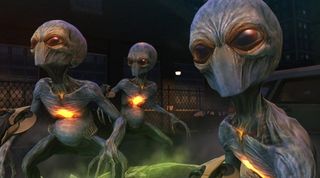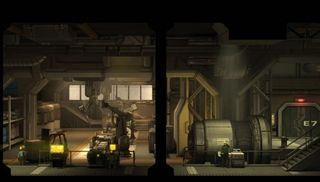XCOM: Enemy Unknown preview

Jake Solomon really loves X-COM. This isn't as notable as how badly Firaxis and publishers 2K Games want you to know that he really loves X-COM. It's not just the lead designer, either. Everyone at Firaxis loves X-COM, I'm told. If someone joins the team and hasn't played X-COM, playing X-COM is their first assignment. I'm reminded repeatedly that the original game was published by MicroProse Software, and that Firaxis were born from the ruins of that company.
You can forgive their anxiety. When 2K Marin announced their own XCOM back in 2010, the internet shook with frustration. Sixteen years after the Gollop brothers' turn-based masterpiece was released, the series was returning – as a first-person shooter. It wasn't what fans wanted.
This is what we wanted. Later this year, Earth's Extraterrestrial Combat Unit will return. XCOM: Enemy Unknown is part remake of the 1994 original, and part sequel. It is developed by the company that created Civilization, under the stewardship of creative director Sid Meier. It is turnbased. It has destructible environments. It has the Geoscape. It has the Skyranger. And I'm just about to see it for the first time. The screen goes black. When it fills again I'm looking at the XCOM organisation's new headquarters.
“We call this the ant farm,” Jake says.

It's a side-on view of a vast underground base, colourful and bustling. It looks nothing like the original game. It looks beautiful. I can see the Skyranger in the hangar bay near the top. I can see soldiers wandering the halls, exercising, playing games in the rec room and visiting injured friends in the infirmary.
“This is where the player returns after every mission.”
Your lavish headquarters are also the game's menu. As Jake selects Science Lab at the top of the screen, the camera swoops in close to show the inside of the laboratory. Here you can set your science team's research goals, unlocking new weapons and equipment to help you in your fight against the aliens.
PC Gamer Newsletter
Sign up to get the best content of the week, and great gaming deals, as picked by the editors.
Switch to the Barracks and the camera shoots across the base. From here you can customise your soldiers' appearance, give them names and nicknames, and manage their equipment and abilities.
Inside the Situation Room, you're faced with a shadowy figure against a glitching, TV static background. XCOM is an international organisation, funded by countries around the world. If those countries are to continue giving you valuable resources, you'll need to keep them happy by occasionally bending your plans to their selfish desires. Selfish desires such as “Please launch some satellites over our country, to keep an eye out for aliens here,” and “Please stop the aliens from killing us all.” They give you scientists and other rewards for helping them, but concentrate too much on servicing those countries and your overall strategy will suffer.

It's the Mission Control room that looks most familiar. Flick to it and the camera switches to a satellite view of Earth, spinning in space. This is the original game's fondly remembered Geoscape. From here you can scan for UFOs in regions covered by your satellites. If you find them, you can go fight them. That might mean scrambling an Interceptor to tackle the UFO in the air, assuming you've built one nearby. Or it might mean picking up to six of your best soldiers and going to fight them on the ground.
Jake does the latter. As the mission loads, the screen shows the Skyranger blasting across the sky. Like everything I've seen so far, it looks updated, but still feels a lot like the original. It's X-COM turned XCOM-nom-nom.
With the original X-COM, British game designer Julian Gollop and his brother Nick set out to create a follow-up to their game Laser Squad. Then called Laser Strike 2, they signed the game with MicroProse, who had just had enormous success with Sid Meier's Civilization. Their new publisher suggested the Gollops bring a similar scale to their next game.
Eventually released as UFO: Enemy Unknown in Europe in 1994, and in America later that same year as X-COM: UFO Defense, the game they created married the squad tactics of Laser Squad to a global strategy layer and a modern day setting. The result was an instant hit.

“If you get ten fans and you say, 'Give me the number one thing that makes it great,' you'd get 15 answers,” says Jake. “It's tough, but I would say high stakes is what XCOM is about.”
When soldiers die in XCOM: Enemy Unknown, as in its predecessors, they die for good. That doesn't sound like a big deal at first – units die in strategy games all the time. But you invest so much more in an XCOM soldier.
Let's imagine. A new recruit joins XCOM, and you name him Jimmy Doyle. He starts off as a rookie, with low stats and a lot of nerves. You customise his appearance, giving him a big nose and a scruffy face. On his first mission, he comes face to face with a Muton. A large, gorilla-like alien, the Muton uses a special ability to pound its chest and panic the inexperienced rookie. Doyle fires wildly without you telling him to, but you get him behind cover before the Muton kills him, and he survives the rest of the mission.
Doyle then levels up to Squaddie and earns himself a nickname. He's now Jimmy 'Popeye' Doyle. At this point in the original X-COM, you'd be putting points into an enormous wall of stats, but that system has completely changed. Recruits now have a small number of stats that level automatically, and when they reach Squaddie, reveal a predilection for one of four classes: Heavy, Sniper, Support or Assault.
Most Popular



